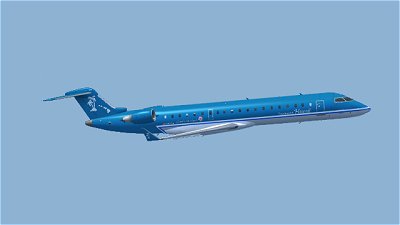Bombardier
CRJ-700ER ~ Posky
Bombardier's 70 seat Canadair CRJ-700 is the first significant development of its fast selling 50 seat Canadair Regional Jet series.
Definition and development work on the Series 700 commenced in 1995 when Bombardier began consultation with a 15 member airline advisory panel on what the airlines wanted in a 70 seat class regional jet. Prior to its January 1997 formal launch the Series 700 was dubbed the CRJ-X.
Construction of the first prototype Series 700 began in late 1998 and first flight took place in May 1999. The CRJ-700 entered service in February 2001 with French airline Brit Air.
Compared with the 50 seat CRJ Series 100/200, the Series 700 is stretched by 4.72m (15ft 6in) with plugs forward and aft of the wing, while the cabin is 6.02m (19ft 9in) longer, aided by moving the rear pressure bulkhead 1.29m (4ft 3in) aft. The cabin windows are raised by 12cm (5in), the cabin floor is lowered slightly and the ceiling raised to provide 1.90m (6ft 3in) headroom, and an underfloor baggage compartment under the forward fuselage is added. Other changes include relocating the APU to the rear fuselage and redesigned overhead stowage bins.
The wing too comes in for attention, with span increased by a 1.83m (6ft 0in) wing root plug, while the leading edge is extended and high lift devices added. The main undercarriage units are lengthened and fitted with new wheels, tyres and brakes.
Power is from two FADEC equipped General Electric CF-34-8C1 turbofans (which were selected in February 1995), while the flightdeck is based on that in the earlier CRJs and features six CRT displays presenting information from the Collins Pro Line 4 EFIS avionics suite.
Like other Bombardier aircraft, the CRJ Series 700 is the product of a joint manufacturing effort. Canadair manufactures the wing and flightdeck and is responsible for final assembly, Mitsubishi builds the aft fuselage, Shorts is responsible for the fuselage and engine nacelles Avcorp the tail, and Westland the tailcone.




